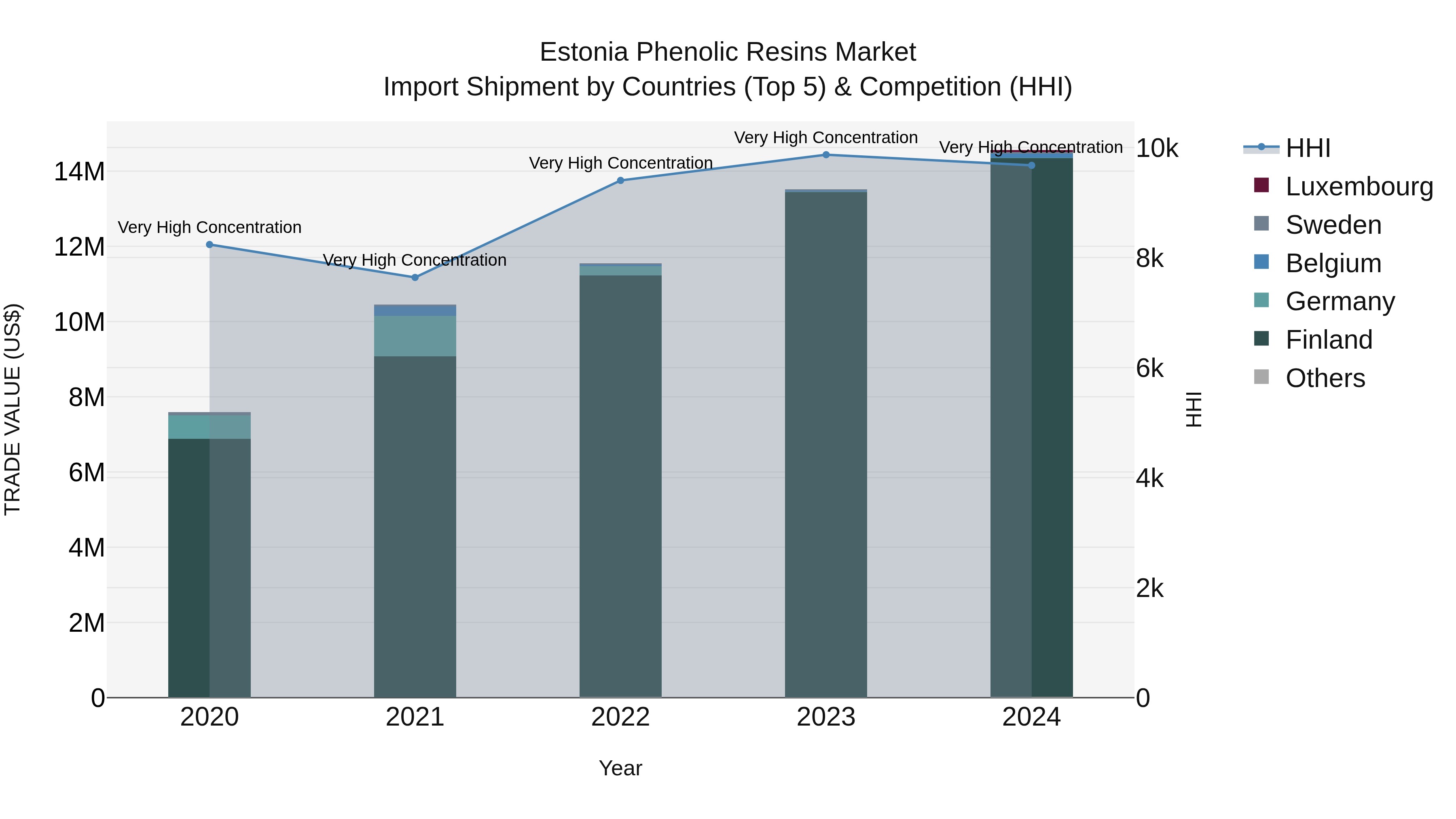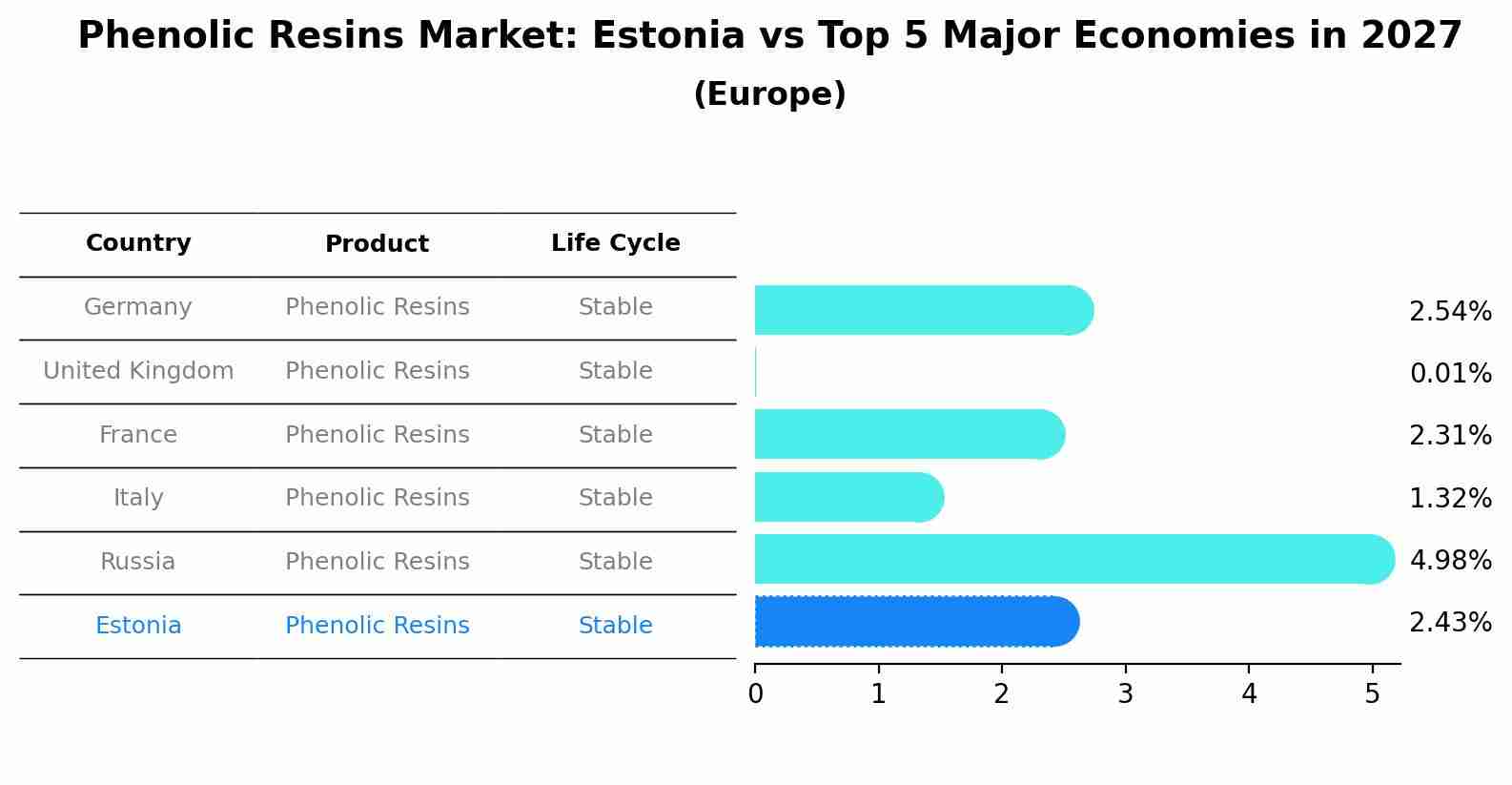Estonia Phenolic Resins Market (2025-2031) | Segmentation, Industry, Forecast, Growth, Value, Companies, Revenue, Size, Analysis, Share, Trends & Outlook
| Product Code: ETC4679371 | Publication Date: Nov 2023 | Updated Date: Nov 2025 | Product Type: Market Research Report | |
| Publisher: 6Wresearch | Author: Shubham Deep | No. of Pages: 60 | No. of Figures: 30 | No. of Tables: 5 |
Estonia Phenolic Resins Market Top 5 Importing Countries and Market Competition (HHI) Analysis
In 2024, Estonia continued to see strong import shipments of phenolic resins, with top exporting countries including Finland, Belgium, Luxembourg, Sweden, and Germany. The high Herfindahl-Hirschman Index (HHI) indicates a concentrated market, suggesting dominant suppliers. The compound annual growth rate (CAGR) from 2020 to 2024 was robust at 17.7%, demonstrating sustained expansion in demand. Moreover, the growth rate from 2023 to 2024 was a notable 7.73%, underscoring the acceleration in import activities. Estonia`s reliance on these key exporting countries highlights the importance of monitoring market dynamics and supplier relationships in the phenolic resins industry.

Phenolic Resins Market: Estonia vs Top 5 Major Economies in 2027 (Europe)
In the Europe region, the Phenolic Resins market in Estonia is projected to expand at a stable growth rate of 2.43% by 2027. The largest economy is Germany, followed by United Kingdom, France, Italy and Russia.

Estonia Phenolic Resins Market Overview
The phenolic resins market in Estonia is growing, driven by their wide application in automotive, electronics, and industrial sectors. Phenolic resins are used in the production of molded parts, coatings, and adhesives. The market is expected to expand due to the rising demand for high-performance materials and the continued growth of the manufacturing sector in Estonia.
Drivers of the market
The phenolic resins market in Estonia is driven by their use in wood adhesives, laminates, and molding compounds. With growing construction and industrial activities, phenolic resins are in high demand due to their durability and heat resistance. Estonias focus on sustainable and high-performance materials supports the market.
Challenges of the market
The phenolic resins market in Estonia faces challenges related to raw material costs, environmental concerns, and competition from alternative materials. Phenolic resins are widely used in automotive, construction, and electronics industries, but their production relies on petrochemical products, which can be subject to price fluctuations. Environmental concerns regarding the use of chemicals in the production process also put pressure on manufacturers to adopt greener alternatives. Additionally, competition from other resins, such as epoxy and polyester, is increasing, limiting the market growth potential of phenolic resins.
Government Policy of the market
Estonias policies in the phenolic resins market are focused on advancing the use of these resins in various industrial applications while ensuring environmental responsibility. Phenolic resins are commonly used in automotive, construction, and electronics industries. The government encourages the development and use of eco-friendly phenolic resins that reduce harmful emissions and are more sustainable. Policies also provide support for industries that adopt advanced technologies to produce phenolic resins with lower environmental impact, while also regulating the safe use and disposal of these chemicals.
Key Highlights of the Report:
- Estonia Phenolic Resins Market Outlook
- Market Size of Estonia Phenolic Resins Market, 2024
- Forecast of Estonia Phenolic Resins Market, 2031
- Historical Data and Forecast of Estonia Phenolic Resins Revenues & Volume for the Period 2021-2031
- Estonia Phenolic Resins Market Trend Evolution
- Estonia Phenolic Resins Market Drivers and Challenges
- Estonia Phenolic Resins Price Trends
- Estonia Phenolic Resins Porter`s Five Forces
- Estonia Phenolic Resins Industry Life Cycle
- Historical Data and Forecast of Estonia Phenolic Resins Market Revenues & Volume By Product for the Period 2021-2031
- Historical Data and Forecast of Estonia Phenolic Resins Market Revenues & Volume By Novolac for the Period 2021-2031
- Historical Data and Forecast of Estonia Phenolic Resins Market Revenues & Volume By Resol for the Period 2021-2031
- Historical Data and Forecast of Estonia Phenolic Resins Market Revenues & Volume By Others for the Period 2021-2031
- Historical Data and Forecast of Estonia Phenolic Resins Market Revenues & Volume By Application for the Period 2021-2031
- Historical Data and Forecast of Estonia Phenolic Resins Market Revenues & Volume By Wood Adhesives for the Period 2021-2031
- Historical Data and Forecast of Estonia Phenolic Resins Market Revenues & Volume By Molding for the Period 2021-2031
- Historical Data and Forecast of Estonia Phenolic Resins Market Revenues & Volume By Insulation for the Period 2021-2031
- Historical Data and Forecast of Estonia Phenolic Resins Market Revenues & Volume By Laminates for the Period 2021-2031
- Historical Data and Forecast of Estonia Phenolic Resins Market Revenues & Volume By Paper Impregnation for the Period 2021-2031
- Historical Data and Forecast of Estonia Phenolic Resins Market Revenues & Volume By Coatings for the Period 2021-2031
- Historical Data and Forecast of Estonia Phenolic Resins Market Revenues & Volume By Others for the Period 2021-2031
- Estonia Phenolic Resins Import Export Trade Statistics
- Market Opportunity Assessment By Product
- Market Opportunity Assessment By Application
- Estonia Phenolic Resins Top Companies Market Share
- Estonia Phenolic Resins Competitive Benchmarking By Technical and Operational Parameters
- Estonia Phenolic Resins Company Profiles
- Estonia Phenolic Resins Key Strategic Recommendations
Frequently Asked Questions About the Market Study (FAQs):
1 Executive Summary |
2 Introduction |
2.1 Key Highlights of the Report |
2.2 Report Description |
2.3 Market Scope & Segmentation |
2.4 Research Methodology |
2.5 Assumptions |
3 Estonia Phenolic Resins Market Overview |
3.1 Estonia Country Macro Economic Indicators |
3.2 Estonia Phenolic Resins Market Revenues & Volume, 2021 & 2031F |
3.3 Estonia Phenolic Resins Market - Industry Life Cycle |
3.4 Estonia Phenolic Resins Market - Porter's Five Forces |
3.5 Estonia Phenolic Resins Market Revenues & Volume Share, By Product, 2021 & 2031F |
3.6 Estonia Phenolic Resins Market Revenues & Volume Share, By Application, 2021 & 2031F |
4 Estonia Phenolic Resins Market Dynamics |
4.1 Impact Analysis |
4.2 Market Drivers |
4.3 Market Restraints |
5 Estonia Phenolic Resins Market Trends |
6 Estonia Phenolic Resins Market Segmentations |
6.1 Estonia Phenolic Resins Market, By Product |
6.1.1 Overview and Analysis |
6.1.2 Estonia Phenolic Resins Market Revenues & Volume, By Novolac, 2021-2031F |
6.1.3 Estonia Phenolic Resins Market Revenues & Volume, By Resol, 2021-2031F |
6.1.4 Estonia Phenolic Resins Market Revenues & Volume, By Others, 2021-2031F |
6.2 Estonia Phenolic Resins Market, By Application |
6.2.1 Overview and Analysis |
6.2.2 Estonia Phenolic Resins Market Revenues & Volume, By Wood Adhesives, 2021-2031F |
6.2.3 Estonia Phenolic Resins Market Revenues & Volume, By Molding, 2021-2031F |
6.2.4 Estonia Phenolic Resins Market Revenues & Volume, By Insulation, 2021-2031F |
6.2.5 Estonia Phenolic Resins Market Revenues & Volume, By Laminates, 2021-2031F |
6.2.6 Estonia Phenolic Resins Market Revenues & Volume, By Paper Impregnation, 2021-2031F |
6.2.7 Estonia Phenolic Resins Market Revenues & Volume, By Coatings, 2021-2031F |
7 Estonia Phenolic Resins Market Import-Export Trade Statistics |
7.1 Estonia Phenolic Resins Market Export to Major Countries |
7.2 Estonia Phenolic Resins Market Imports from Major Countries |
8 Estonia Phenolic Resins Market Key Performance Indicators |
9 Estonia Phenolic Resins Market - Opportunity Assessment |
9.1 Estonia Phenolic Resins Market Opportunity Assessment, By Product, 2021 & 2031F |
9.2 Estonia Phenolic Resins Market Opportunity Assessment, By Application, 2021 & 2031F |
10 Estonia Phenolic Resins Market - Competitive Landscape |
10.1 Estonia Phenolic Resins Market Revenue Share, By Companies, 2024 |
10.2 Estonia Phenolic Resins Market Competitive Benchmarking, By Operating and Technical Parameters |
11 Company Profiles |
12 Recommendations | 13 Disclaimer |
- Single User License$ 1,995
- Department License$ 2,400
- Site License$ 3,120
- Global License$ 3,795
Search
Thought Leadership and Analyst Meet
Our Clients
Related Reports
- Germany Breakfast Food Market (2026-2032) | Industry, Share, Growth, Size, Companies, Value, Analysis, Revenue, Trends, Forecast & Outlook
- Australia Briquette Market (2025-2031) | Growth, Size, Revenue, Forecast, Analysis, Trends, Value, Share, Industry & Companies
- Vietnam System Integrator Market (2025-2031) | Size, Companies, Analysis, Industry, Value, Forecast, Growth, Trends, Revenue & Share
- ASEAN and Thailand Brain Health Supplements Market (2025-2031) | Strategy, Consumer Insights, Analysis, Investment Trends, Opportunities, Growth, Size, Share, Industry, Revenue, Segments, Value, Segmentation, Supply, Forecast, Restraints, Outlook, Competition, Drivers, Trends, Demand, Pricing Analysis, Competitive, Strategic Insights, Companies, Challenges
- ASEAN Bearings Market (2025-2031) | Strategy, Consumer Insights, Analysis, Investment Trends, Opportunities, Growth, Size, Share, Industry, Revenue, Segments, Value, Segmentation, Supply, Forecast, Restraints, Outlook, Competition, Drivers, Trends, Demand, Pricing Analysis, Competitive, Strategic Insights, Companies, Challenges
- Europe Flooring Market (2025-2031) | Outlook, Share, Industry, Trends, Forecast, Companies, Revenue, Size, Analysis, Growth & Value
- Saudi Arabia Manlift Market (2025-2031) | Outlook, Size, Growth, Trends, Companies, Industry, Revenue, Value, Share, Forecast & Analysis
- Uganda Excavator, Crane, and Wheel Loaders Market (2025-2031) | Strategy, Consumer Insights, Analysis, Investment Trends, Opportunities, Growth, Size, Share, Industry, Revenue, Segments, Value, Segmentation, Supply, Forecast, Restraints, Outlook, Competition, Drivers, Trends, Demand, Pricing Analysis, Competitive, Strategic Insights, Companies, Challenges
- Rwanda Excavator, Crane, and Wheel Loaders Market (2025-2031) | Strategy, Consumer Insights, Analysis, Investment Trends, Opportunities, Growth, Size, Share, Industry, Revenue, Segments, Value, Segmentation, Supply, Forecast, Restraints, Outlook, Competition, Drivers, Trends, Demand, Pricing Analysis, Competitive, Strategic Insights, Companies, Challenges
- Kenya Excavator, Crane, and Wheel Loaders Market (2025-2031) | Strategy, Consumer Insights, Analysis, Investment Trends, Opportunities, Growth, Size, Share, Industry, Revenue, Segments, Value, Segmentation, Supply, Forecast, Restraints, Outlook, Competition, Drivers, Trends, Demand, Pricing Analysis, Competitive, Strategic Insights, Companies, Challenges
Industry Events and Analyst Meet
Whitepaper
- Middle East & Africa Commercial Security Market Click here to view more.
- Middle East & Africa Fire Safety Systems & Equipment Market Click here to view more.
- GCC Drone Market Click here to view more.
- Middle East Lighting Fixture Market Click here to view more.
- GCC Physical & Perimeter Security Market Click here to view more.
6WResearch In News
- Doha a strategic location for EV manufacturing hub: IPA Qatar
- Demand for luxury TVs surging in the GCC, says Samsung
- Empowering Growth: The Thriving Journey of Bangladesh’s Cable Industry
- Demand for luxury TVs surging in the GCC, says Samsung
- Video call with a traditional healer? Once unthinkable, it’s now common in South Africa
- Intelligent Buildings To Smooth GCC’s Path To Net Zero


















